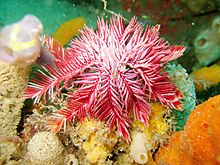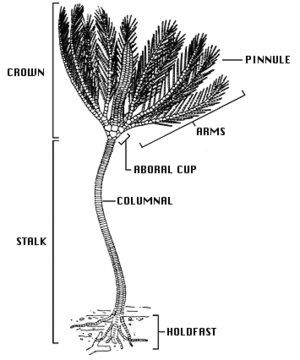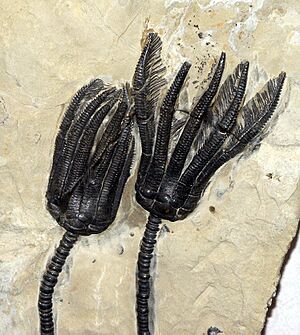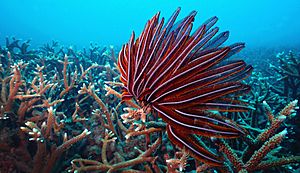Crinoids facts for kids
Quick facts for kids Crinoids |
|
|---|---|
 |
|
| A Passion Flower feather star (Ptilometra australis) |
|
| Scientific classification | |
| Kingdom: | |
| Phylum: | |
| Class: |
Crinoidea
Miller 1821
|
The Crinoids are a group of amazing sea animals called Echinoderms. They are related to starfish and sea urchins. Crinoids come in two main types: sea lilies and feather stars. Sea lilies look like plants, with a long stalk that attaches them to the ocean floor. Feather stars are free-living and can move around.
You can find crinoids all over the ocean, from shallow waters near the coast to super deep parts, even 6000 meters down! Like other echinoderms, crinoids have a cool five-part symmetry, meaning their body parts often repeat in fives. Most crinoids have many more than five arms. Their mouth is on their top surface, surrounded by these feeding arms.
Crinoids have a very long history. They were the first echinoderms to appear in the fossil record. This means we have found their ancient remains. They have kept their basic body plan for a very long time. Crinoids were super common during the Paleozoic Era, which was millions of years ago. Some rocks from the Carboniferous period are almost entirely made of fossil crinoids!
Contents
Crinoid Body Parts
Crinoids have their mouths facing upwards, towards the ocean surface. The stalked sea lilies eat tiny bits of food and dead plants or animals that float down to the bottom. Their mouth is surrounded by many feathery arms or tentacles. Crinoids have a U-shaped gut, which is their digestive system. Their anus, where waste leaves the body, is located right next to their mouth.
A Look at Crinoid History
Crinoids almost disappeared during a huge extinction event at the end of the Palaeozoic era. This was a time when many types of life on Earth died out. Four whole groups of crinoids became extinct. Only a few survived, and these became the only living group we see today, called the Articulata.
The stalked sea lilies faced many dangers from predation (being hunted) in the Mesozoic Era. Because of this, almost all the remaining sea lilies now live in very deep water. There, fewer animals compete for food or try to eat them. The free-living feather stars, however, have been much more successful.
In 2005, something amazing was filmed! A stalked crinoid was seen pulling itself along the sea floor. This happened off the Grand Bahama Island. The video showed the crinoid moving much faster than scientists thought was possible for these animals.
All About Feather Stars
The free-living feather stars first appeared in the Upper Triassic period. They are related to starfish. When they are young, feather stars are attached to the sea bottom by a stalk, just like their ancient ancestors. But as they grow into adults, they break away from this stalk. Then they can move around freely!
Some feather stars can even swim by moving their arms in a wavy motion. Usually, though, they crawl around using small, claw-like parts called cirri. These are found at the bottom of their main body. Feather stars are the only crinoids that live in shallow water. They all belong to a group called the Comatulidae. Their flexible arms and their ability to choose where they feed helped them survive and become very successful.
During the day, feather stars often roll themselves into a ball. But at night, they spread out their arms. This helps them catch tiny food particles, like plankton, that float in the water. Feather stars position themselves so their fan-like arms face the ocean current. This way, they can catch the most food particles as the water flows by.
Images for kids
-
Stalked crinoid drawn by Ernst Haeckel
-
Agaricocrinus americanus, a fossil crinoid from the Carboniferous of Indiana
-
Middle Jurassic (Callovian) Apiocrinites crinoid pluricolumnals from the Matmor Formation in southern Israel
See also
 In Spanish: Crinoideos para niños
In Spanish: Crinoideos para niños
















